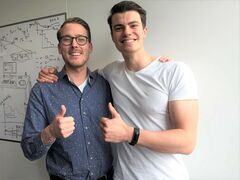Which is the fittest department?
TU/e departments will go head to head in the field of sports starting next week. Which department is the fittest? Will it be the students and staff of Industrial Engineering & Innovation Sciences or of the Department of the Built Environment, or perhaps those of the Department of Applied Physics? Let the battle for the title ‘Fittest Faculty 2019’ begin.
The competition is the brainchild of Jens d’Hondt, a third-year bachelor’s student of Industrial Engineering with a passion for sports and technology. So far, 140 participants have entered into the competition, but there is room for more. People can still register, provided they do so quickly. Registration closes on Monday, April 29. Click here to subscribe. Or scan the QR-code.
Distance
“The competition will start next week and ends on June 5. In those six weeks, participants can earn points by exercising a lot. It’s less about running or cycling for half an hour than about daily activities on campus. Get your cup of coffee at a different faculty building, for instance. That way, you cover a distance as well”, explains Jens.
People can make ‘fitpics’ of the assignments. The photo serves as evidence of their physical exertion. The score increases depending on the number of fitpics you make.
Experiment
PhD student Raoul Nuijten of the research group Information Systems started a similar fitness campaign last year. D’Hondt has invited last years’ participants. Practically everyone agreed to take part in the competition once more. He now has enough ‘material’ for his experiment. Because the underlying intention of the competition is to test how positive feedback influences the participants.
Personalized encouragements
D’Hondt: “I developed an algorithm that sends personal messages to people. Participants briefly indicate whether these message appeal to them using simple ‘feedback buttons.’ The program learns one's character and takes it into account when drafting future personalized messages. A more outgoing person will receive a message along the lines of ‘Well done, now go for a walk with someone else.’ A more result-driven person will receive a different kind of feedback. ‘Fine, you’re in third place now. Go out for an extra round on your bike tomorrow and you’ll be in second place.’ Participants will not receive feedback during the first two weeks, and only then do we start sending personalized encouragements so that we can measure the effect more clearly.”
Game Bus
The exchange of activities and encouragements is done by email. Participants can indicate how they experience the feedback in a simple manner. There is an app, the ‘Game Bus,’ as well. It gives a clear overview of the fitness activities and feedback during a period of six weeks.
The experiment isn’t necessarily about the effect of positive feedback, d’Hondt warns. He says its main purpose is to figure out whether it is possible to stimulate people in this way.
“The participants are neatly spread out over the different departments,” says the bachelor’s student. “The fittest faculty will receive a trophy in June. The person who earned the most points will be awarded a separate price.”
![[Translate to English:] Foto: Shutterstock](/fileadmin/_processed_/6/1/csm_Fitste_Faculteit_hoofdfoto_d3d8a3ac70.jpg)





Discussion